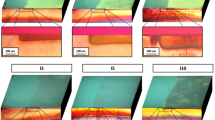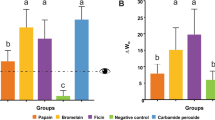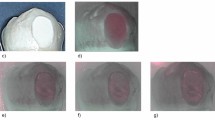Abstract
Background Professional and consumer interest in whitening products continues to increase against a background of both increased oral health awareness and demand for cosmetic procedures. In the current legal climate, few dentists are providing 'in-office' whitening treatments, and thus many patients turn to home-use products. The most common of these are the whitening toothpastes. Researchers are keen to quantify the effectiveness of such products through clinically relevant trials.
Aim Previous studies examining whitening products have employed a variety of stained substrates to monitor stain removal. This study aimed to quantify the removal of stain from human enamel using a new device, quantitative light-induced fluorescence (QLF). The experimental design follows that of a product-testing model.
Materials and method A total of 11 previously extracted molar teeth were coated with transparent nail varnish leaving an exposed window of enamel. The sound, exposed enamel was subject to a staining regime of human saliva, chlorhexidine and tea. Each of the eleven teeth was subjected to serial exposures of a positive control (Bocasan), a negative control (water) and a test product (Yotuel toothpaste). Following each two-minute exposure QLF images of the teeth were taken (a total of 5 applications). Following completion of one test solution, the teeth were cleaned, re-stained and the procedure repeated with the next solution. QLF images were stored on a PC and analysed by a blinded single examiner. The ΔQ value at 5% threshold was reported. ANOVA and paired t-tests were used to analyse the data.
Results The study confirmed the ability of QLF to longitudinally quantify stain reduction from human enamel. The reliability of the technique in relation to positive and negative test controls was proven. The positive control had a significantly (α=0.05) higher stain removal efficacy than water (p=0.023) and Yotuel (p=0.046). Yotuel was more effective than water (p=0.023).
Conclusion The research community, the practicing clinician and the consumer all require sound product evaluation data. The use of human enamel specimens may offer more relevant clinical data. QLF has been designed as an in vivo device. Further development of the technique should permit in vivo clinical whitening trials.
Similar content being viewed by others
Main
With the measurable improvement in the nation's oral health, many individuals are looking to enhance their appearance through 'whiter' teeth, rather than simply seeking restorative treatments.1,2,3 The use of professionally applied bleaching products has come under judicial scrutiny in the UK, and with no clear message to practitioners, many do not offer such procedures. Patients must therefore use 'at-home' products to achieve tooth colour change, typically through the removal of extrinsic stain. The majority of these products are marketed as tooth-whitening dentifrices.
The causes of extrinsic tooth staining are complex and have been covered in the literature recently.4 The method of action of these pastes is believed to be a combination of mechanical and chemical effects.5 Research has assessed both of these modalities, with the current study concentrating on the chemical properties.6 In order to properly assess these toothpastes a number of studies have been performed. One of the most comprehensive was by Sharif et al.5 The techniques used in Sharif's paper were developed by Addy and involve the use of stained Perspex with spectrophotometer analysis.7 The strengths of such a technique include the ability to control the application of the stain, the exposure of the test product to the specimen and also to longitudinally monitor any reduction in stain.
However, it would be ideal to retain these experimental strengths while using a more authentic stained substrate, human enamel. Using a new technology for the detection of early carious lesions, the current study describes such a technique.
Quantitative light-induced fluorescence (QLF)
The detection of very early (and hence reversible) carious lesions by optical methods has been a major research focus of cariologists.8 One of the most promising devices is the QLF (Inspektor Research Systems BV, NL).9,10 The underlying principle of the QLF technique is that teeth will auto-fluorescence under certain light conditions, and that demineralised enamel will fluoresce less than sound enamel. When examined under the QLF, demineralised lesions appear as dark areas. With analytical software, the loss of fluorescence characteristic of demineralised areas can be compared with the unaffected fluorescence of the sound enamel and a quantifiable value, ΔQ, reported. Developed from early experimentation with lasers, the QLF device has been the subject of numerous validation articles.11,12 The QLF handpiece is shown in Figure 1.
QLF and staining
Amaechi has described the potential for QLF to quantify stain removal.13 The stain produced on the teeth appears on the QLF image in a similar manner to demineralised lesions. The analytical software is able to compare the stained enamel to adjacent unstained enamel in the same way as demineralised and sound enamel is compared. This study furthers the initial work by incorporating it into a product-testing model. By employing this mechanism a longitudinal and quantifiable analysis of stain reduction on human enamel specimens is possible.
Materials and methods
A total of 11 previously extracted human mandibular third molars were selected. Buccal surfaces were devoid of intrinsic stain, enamel cracks or fractures, caries or other enamel defects. The teeth were gently pumiced and their buccal surfaces gently abraded with wet-and-dry paper. Clear nail varnish (MaxFactor, Proctor and Gamble, Ltd., UK) was applied to the buccal surfaces leaving an exposed window, mean area 13 mm2. The teeth were then mounted into the black plastic caps of 50 ml bottles with dental compound (Kerr Dental, UK). The caps containing the teeth were attached to a series of 50 ml bottles (Jencons PLC, UK) containing 30 ml of a)human saliva, b)chlorhexidine mouthwash and c)tea. The specimens were gently agitated in an orbital incubator at 37°C for a total of two minutes in each solution. The teeth were subjected to two staining cycles. Following staining, the nail varnish was removed leaving a stained area surrounded by periphery of un-stained enamel (see Figure 2).
The QLF camera was mounted in a fixed position over a laboratory jack (see Figure 3). Each cap was placed onto the jack's platform and baseline QLF images taken. Fine focussing of the QLF image was obtained by the adjustment of the jack in vertical relation to the QLF camera. Markings on the platform and plastic caps enabled reproducible placement of the teeth on each occasion. Black plastic caps reduced internal reflection of the QLF light source, providing a sharp clear image.
Three test preparations were used. Bocasan (Oral B, UK) as a positive control, distilled water as a negative control and Yotuel whitening toothpaste (Yotuel Classic, Biocosmetics, Spain) as a test product. The test preparations were prepared as per Sharif's method; Bocasan, 1 sachet dissolved in 15 ml of water and Yotuel as a slurry (3 g in 15 ml of water). Each specimen was gently agitated in the solution for 2 minutes at 37°C. Following each application, the specimen was gently washed and 5 QLF images taken. This was repeated for 5 applications (10 minutes total exposure). An example of the image series obtained is shown in Figure 4.
Following completion, the teeth were cleaned, re-stained and the procedure repeated with the next test preparation. Immediately following cleaning, baseline QLF images were taken to ensure the integrity of the enamel. These images were compared with the baselines for previous staining cycles to ensure no demineralisation or other optical event had occurred.
QLF images were stored on a PC and were analysed by a single, blinded examiner using QLF V2.00 (Inspektor Research Systems BV, NL). The QLF analysis method is illustrated in Figure 5. Following capture of the image, an analysis 'patch' was placed around the area of interest (AOI), in this case the stained area. It was essential that the borders of the patch fell on sound, or unstained, enamel. The image was then analysed by the software and the reconstructed stained area shown. The reconstruction was checked to ensure that it mimicked the original AOI morphology, and if inconsistencies were noted, the analysis was repeated. Mean ΔQ values were reported and the % stain removed calculated. ANOVA followed by paired t-tests was used to analyse significant differences between the test preparations.
a) The patch is placed around the area of interest, ensuring that the blue border lies entirely on sound (unstained) enamel. b)The reconstructed tooth shows a homogenous area where the stain has been removed, indicating correct patch placement. c)The reconstructed stain matches the morphology of the original image, again confirming correct patch placement. d)The values for ΔF, area and ΔQ are given at several different threshold levels. e)Here the patch has not been correctly placed, with the left-hand border resting on stained enamel. f)The reconstructed tooth shows streaking, indicating poor patch placement. g) The morphology of the reconstructed stain does not match that of the original stained area. h) The difference in the QLF data can be seen as a result of the incorrect patch placement.
Results
Mean baseline (unstained) ΔQ values for each test preparation were 1.76 (±2.90) (Bocasan), 3.29 (±5.16) (water) and 1.72 (±2.79) (Yotuel). Mean baseline (stained) ΔQ values for each test preparation were 240.80 (±119.67) (Bocasan), 235.12 (±110.97) (water) and 326.35 (±134.39) (Yotuel). The % decrease in stain following each exposure to test preparation is shown in Figure 6.
Bocasan had significantly better extrinsic stain removal than water (p=0.005) and Yotuel (p=0.046). Yotuel had significantly better extrinsic stain removal than water (p=0.023). Alpha was pre-set at 0.05.
Discussion and conclusions
Many novel techniques have been suggested for the quantification of stain removal from enamel specimens. McCaslin et al used digitised photographs and NIH Image (National Institutes of Health, US) to detect whitening via 256 shades of grey.14 However, studies that examined the presence of white spots adjacent to orthodontic brackets (a broadly similar technique) found that photographs were sensitive to flash reflections, angulation and magnification factors that must be tightly controlled.15 Amaechi used the ShadeEye device (Shofu, USA) to longitudinally monitor extrinsic stain removal from enamel.16 However the ShadeEye device does not permit the user to visualize the tooth image and provides quantitative data via printout only. The reliability and operational definition of this device for stain removal has not been determined and further research is required to assess its use in product testing models. Other groups have used a combination of optical (colorimeter), photographic (35 mm slides, subsequently digitised) and shade guide techniques to monitor in vivo changes.17 The comparison of such techniques in terms of reliability and validity (i.e. what exactly are they measuring?) has yet to be carried out.
The QLF images, and their subsequent analysis demonstrate the ability of the technique to quantifiably monitor the longitudinal decrease in stain following application of test products with appropriate positive and negative controls. The described methodology represents a more authentic stained substrate in the form of human enamel. The study has shown that the Yotuel product is able to remove artificial extrinsic stain from teeth. The QLF analysis software enables visualisation of stain reduction, in combination with a quantitative assessment of the action of the test preparations. There are several advantages of the QLF technique over other optical methods. As QLF uses the auto-fluorescence of the teeth to produce an image, a flash is not required. This reduces image variability between exposures and increases the reliability of the technique. By storing the captured digital images QLF permits the blinded assessment of the data and, of particular importance in product testing trials, the ability for other interested parties to examine the raw data obtained during trials. The same examiner, using the same images, can repeat QLF analyses and thus repeat testing and verification is possible. Analysed images are stored with their unanalysed counter-parts and may easily be archived. A technique such as a colorimeter or the ShadeEye does not permit such archiving or blind testing.
The QLF device was primarily designed as an in vivo device to detect and quantify early enamel demineralisation. Its application to stain measurement has been demonstrated. The in vivo capability of the device will allow future clinical trials on whitening products to be conducted out of the laboratory and thus increase the validity of product testing. Further research to incorporate the more generalised staining of teeth in situ into the methodology is required. The difficulty arises from the need for QLF to compare stained tissue to unstained. The use of a generic stain-free mask over the acquired in vivo images may resolve this problem. Methods such as photographic assessment and the ShadeEye do not suffer this problem, as they do not require un-stained enamel to conduct a comparison. As such the QLF technique requires subjective input from the examiner at the image analysis stage (the placement of the analysis patch, see Figure 5). Such subjectivity could introduce variability to the assessment of stain reduction. A study performed looking at the reliability and effect of subjectivity on QLF analyses found that both intra- and inter-examiner reproducibility was high when assessing in vitro caries lesions.18 The assessment of stain reduction is simpler, and it is reasonable to extrapolate these results to the reliability of stain assessment. Reliability can also be increased by using multiple examiners or repeated measures by the same examiner.18
QLF presents an expeditious, user-friendly, economical and resilient method of assessing stain reduction. The data produced can be archived and the ability to blind examiners and conduct repeated analysis of the images strengthens studies employing QLF. Its ability to longitudinally monitor stain reduction from enamel specimens in vitro has been proven and its use in product testing demonstrated. The future could present the general practitioner with a method of quantifying, and therefore documenting, the effectiveness of any whitening procedure. Such a technique would satisfy medico-legal and patients' requirements for proof of efficacy.
References
Pine C M, Pitts B P, Steele J G, Nunn J N, Treasure E . Dental restorations in adults in the UK in 1998 and implications for the future. Br Dent J 2001; 190: 4–8.
Downer M C . The caries decline. A comment in light of the UK experience. Eur J Oral Sci 1996; 104: 433–435.
Petersson G H, Bratthall D . The caries decline: a review of reviews. Eur J Oral Sci 1996; 104: 436–43.
Watts A, Addy M . Tooth discolouration and staining. A review of the literature. Br Dent J 2001; 190: 309–316.
Sharif N, MacDonald E, Hughes J, Newcombe R G, Addy M . The chemical stain removal properties of 'whitening' toothpaste products: studies in vitro. Br Dent J 2000; 188: 620–624.
Volpe A R, Petrone M E, DeVizio W, Emling R C, Yankell S L . A new perspective on the methodology for clinical efficacy evaluations of tooth whitening dentifrices. J Clin Dent 1999; 10: 95–98.
Addy M, Goodfield S, Harrison A . The use of acrylic to compare the abrasivity and stain removal properties of toothpastes. Clin Mater 1991; 15: 32–39.
Van der Veen M H, de Josselin de Jong E . Application of quantitative light-induced fluorescence for assessing early caries lesions. Monogr Oral Sci 2000; 17: 144–162.
Al-Khateeb S, ten Cate J M, Angmar-Mansson B et al. Quantification of formation and remineralization of artificial enamel lesions with a new portable fluorescence device. Adv Dent Res 1997; 11: 502–506.
De Josselin de Jong E, Sundstrom F, Westerling H, Tranaeus S, ten Bosch J J, Angmar-Mansson B . A new method for in vivo quantification of changes in initial enamel caries with laser fluorescence. Caries Res 1995; 29: 2–7.
Shi X Q, Tranaeus S, Angmar-Mansson B . Comparison of QLF and DIAGNOdent for quantification of smooth surface caries. Caries Res 2001; 35: 21–26.
Lagerweij M, van der Veen M, Ando M, Lukantsova L, Stookey G . The validity and repeatability of three light-induced fluorescence systems: An in vitro study. Caries Res 1999; 33: 220–226.
Amaechi B T, Higham S M . QLF, A potential tool for general dental assessment. J Biomed Optic 2002; 6; In Press.
McCaslin A J, Haywood V B, Potter B J, Dickinson G L, Russell C M . Assessing dentin color changes from nightguard vital bleaching. J Am Dent Assoc 1999; 130: 1485–1490.
Benson P E, Pender N, Higham S M . Enamel demineralisation assessed by computerised image analysis of clinical photographs. J Dent 2000; 28: 319–326.
Amaechi B T, Higham S M . Development of a quantitative method to monitor the effect of a whitening agent. J Clin Dent 2002 In Press.
Mokhlis G R, Matis B A, Cochran M A, Eckert G J . A clinical evaluation of carbamide peroxide and hydrogen peroxide whitening agents during daytime use. J Am Dent Assoc 2000; 131: 1269–1277.
Pretty I A, Hall A F, Edgar W M, Higham S M . The Intra- and Inter-examiner reliability of QLF analyses. Caries Res 2001; 35: 269.
Author information
Authors and Affiliations
Corresponding author
Additional information
R efereed P aper
Rights and permissions
About this article
Cite this article
Pretty, I., Edgar, W. & Higham, S. The use of QLF to quantify in vitro whitening in a product testing model. Br Dent J 191, 566–569 (2001). https://doi.org/10.1038/sj.bdj.4801235
Received:
Accepted:
Published:
Issue Date:
DOI: https://doi.org/10.1038/sj.bdj.4801235
This article is cited by
-
The evaluation of a novel method comparing quantitative light-induced fluorescence (QLF) with spectrophotometry to assess staining and bleaching of teeth
Clinical Oral Investigations (2010)
-
Impact of Streptococcus mutans on the generation of fluorescence from artificially induced enamel and dentin carious lesions in vitro
Odontology (2008)
-
In vitro quantitative light-induced fluorescence to measure changes in enamel mineralization
Clinical Oral Investigations (2006)
-
A study to assess the efficacy of a new detergent free, whitening dentifrice in vivo using QLF planimetric analysis
British Dental Journal (2004)
-
Quantifying whitening using quantitative light-induced fluorescence in a product test model
British Dental Journal (2001)









